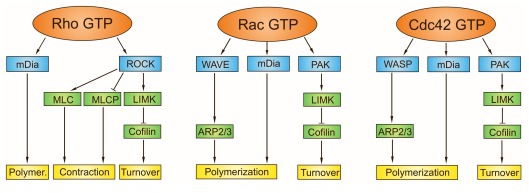Figure 7.
Downstream effector targets of Rho family GTPases for generation of actin cytoskeletal structures. The downstream targets of active Rho GTPases, with bound GTP, include kinases (p21-activated kinase, PAK; Rho-associated coiled-coil kinase; ROCK) and nucleation promoting factors (mammalian Diaphanous formin, mDia; Wiskott-Aldrich syndrome protein, WASP; Wiskott-Aldrich syndrome protein-family verprolin homologous protein, WAVE). While nucleation by mDia produces unbranched actin filaments, WASP and WAVE interact with Arp2/3 complex and generate branched microfilaments. PAK phosphorylates LIM-motif containing kinase (LIMK), that in turn phosphorylates and inhibits cofilin thereby regulating the actin-filament turnover. Besides stimulating the actin-filament growth, Rho GTPase promotes myosin actin interactions through ROCK. The ROCK phosphorylates a number of actin cytoskeleton regulators including myosin II light chain (MLC), myosin light chain phosphatase (MLCP), and LIMK. Direct phosphorylation of MLC or MLCP has an immediate impact on the level of phosphorylated myosin light chain, which contributes to contractility. Rho mainly activates the formation of stress fibers and focal adhesions, Rac activates the formation of lamellipodia and membrane ruffles, and Cdc42 activates the formation of filopodia.

